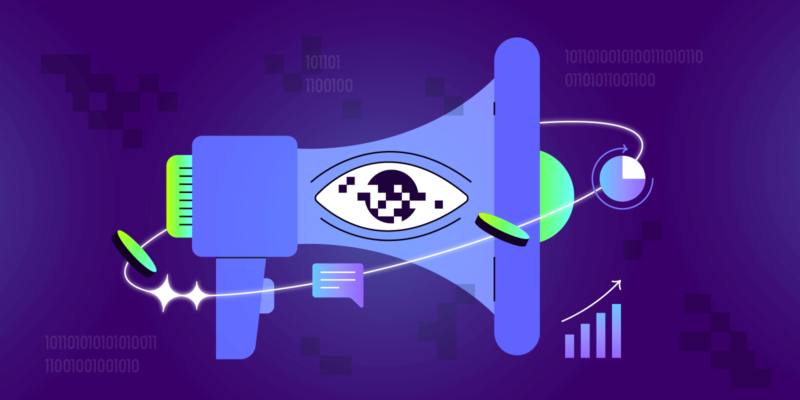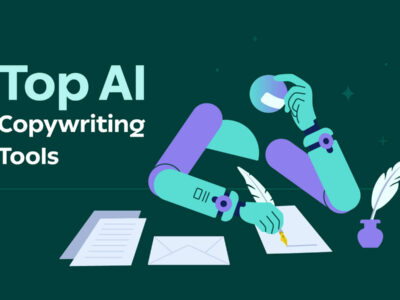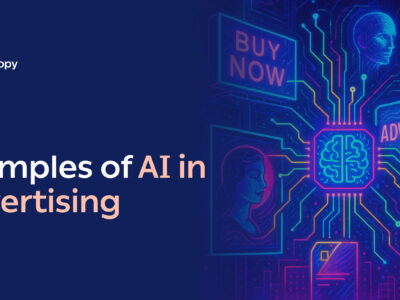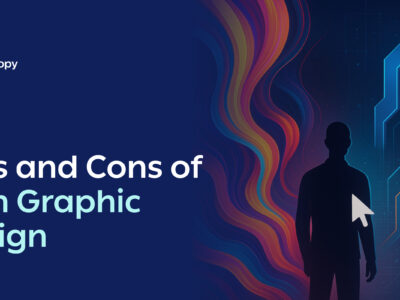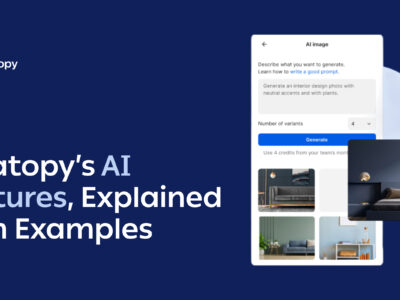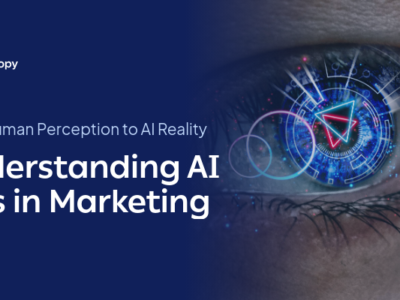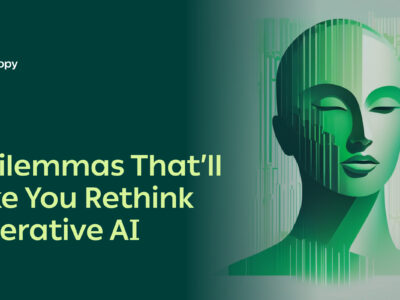Mad Men, episode 14, season 7. The Monolith.
A massive, room-sized computer is installed in what once played as the copywriters’ hanging-out room, unsettling them—physically and, in some cases, emotionally too.
If you’ve been around for at least twelve months, you know the shockwaves ChatGPT sent into the world at the end of 2022. And in an eerily familiar way, you can almost feel the Mad Men characters’ anxiety, even if the two events happen:
- In a fictional world (Mad Men) vs. the real world (this one, where you’re reading his article)
- Six decades apart (give or take)
Despite the differences, both the Mad Men scene and the ChatGPT hype have something in common: it’s revolution. Which, yes, can be scary, but also an opportunity for everyone to be better.
In the Mad Men era, AI marketing may have seemed like a fuzzy idea you could not fully grasp yet. Slowly crawling into the world of creatives, yet not enough to make them feel threatened or helped in any real way. The machine in the copywriters’ ideation room crunched data to predict the best ad placements, but it was still far from assisting creatives per se.
…Which is not at all true for 2023 AI marketing tools.
…And that should make you very, very happy.
Here’s why.
The Fight for Attention
Here’s a stat you probably saw before but likely doesn’t cease to amaze: the average person sees between 4,000 and 10,000 ads every day. They may not all be banners or TV ads, but they are advertising one way or another.
It seems like the exaggeration of the century, but think of it this way: your alarm is probably on your phone. You wake up, and you see the logo on your phone. Maybe you open your Insta or LinkedIn to see if you have any notifications. That’s another one or two logos you see, plus the ads that pop in your feed, all likely less than 100 seconds after you wake up.
By the time you’ve had your breakfast, you’ve seen at least another 10 or 20 ads: the cereal box, the milk box, the orange juice, the eggs in your fridge, the brand names on your kitchen appliances, your coffee maker, your brand of coffee…and the list goes on.
Thirty minutes after waking up, you’ve already been exposed to at least a couple dozen ads in different formats. And you didn’t even leave the house yet—or spent any real-time on the internet, for that matter.
As a consumer, the fight for your attention is fiercer than ever. We do have more channels of communication than ever, true. And marketers can segment their messages down to the nitty-gritty, for sure. But the truth is that brands are competing for attention in an incredibly crowded and noisy marketplace.
That also means designers and copywriters have to churn more content than ever: thousands of ads pushed every day by brands in the same industry, by teams that are frequently undermanned for the task—and overworked to the point of burnout.
AI tools for marketing have come to change this paradigm.
They cannot, and likely will never, replace the human creative process of ideating, writing, and designing marketing assets.
However, they can help teams produce content quickly and efficiently, allowing them to focus their energy on the quality of their output instead of how much content they can push out in a day.
Here’s our take on AI and what’s next for Creatopy.
Why Use AI in Digital Marketing?

According to HubSpot’s State of AI survey, 68% of marketing leaders think implementing AI in their company’s processes would lead to unprecedented growth.
That might seem presumptuous, but the same survey shows that 62% of companies have already implemented AI in their work processes, and 72% of them report better ROI, while 71% report improved productivity.
Likewise, our own research in The State of Digital Advertising 2023 revealed almost half of our respondents planned to use AI in advertising for copy, scripts, and image generation this year.
AI and marketing are not new relationships either. In 2018, a McKinsey report on the “frontier” of AI showed how, due to the high amount of data collected by marketing teams and the way AI mapped to marketing processes, it was a great fit for the industry.
Whatever hype you see now on Twitter and LinkedIn has been long foretold by actual research. It’s not happenstance, it’s a self-fulfilling prophecy.
And data shows Artificial Intelligence tools in marketing are making a real impact. Here’s a quick list of the benefits you should consider if you haven’t jumped the AI bandwagon yet:
Better automation
AI tools can help automate processes like content production, ad placement, and analytics. This not only allows companies to produce more content or ads in a shorter period of time, but also helps them analyze the performance of their campaigns faster, leading to better decision-making for future activities.
Improved efficiency
With AI marketing tools, you don’t need to manually analyze a gigantic pile of data to make sure your campaigns are working as expected. AI tools can do that for you and give you insights faster than any human could ever do!
Ad targeting
AI tools help marketers identify who their ideal customers are, what kind of content they like, which channels they use the most, and so on. This helps teams send the right message, to the right people, in the right place and with the right timing for maximum efficiency.
More room for actual creativity
“Efficiency” is a word that isn’t frequently associated with creativity. But in a world where companies fight for the attention of their audience, the power is in number AND unique angles. Unfortunately, even the biggest teams in the world would succumb to that kind of pressure: to output immense quantity AND make it original, outstanding, scroll-stopping good every time is a pipe dream.
Or at least it used to be before the emergence of AI tools meant to help marketers, advertisers, and designers. Where AI tools take the wheel of mundane tasks, teams can finally focus on their higher-level creative process and take bold risks that could make a difference in their campaigns.
What Is AI in Marketing?
AI marketing refers to marketing functions performed with the assistance of an AI. Marketing and AI tools can be used for various tasks, from analyzing customer behavior to AI content marketing assistants and image generation tools supercharging creatives and marketers to achieve peak performance, even in the most competitive fields.
What Types of AI Are Useful for Marketing Teams?

A lot of people use the term “AI” to define what is, in fact, a very specific type of Artificial Intelligence. Knowing what the most popular types of AI do will help you determine which tools can actually help your business (and which may not be a good fit for you right now).
In essence, most of the marketing AI tools on the market fall into one or more of the following categories:
Machine learning
Machine learning is one of the most widespread types of AI (and the main category from which other AI categories have emerged too). In a nutshell, machine learning is a type of AI that allows machines to learn by being exposed to data sets and building models from them.
Machine learning marketing tools can be used for tasks like forecasting sales or analyzing customer behavior—a perfect fit for marketing teams looking to get insights on their audience to better target their campaigns.
Natural Language Processing (NLP)
NLP is a type of AI that deals with understanding and analyzing human language. For example, ChatGPT is one of the most popular Natural Language Processing tools of the moment.
This is very useful for marketers, as it helps them understand customer sentiment in reviews or social media posts, detect the intent behind customers’ questions (and provide better support), recognize brands in images, and much more.
Generative AI
Generative AI refers to a category of AI tools that help users create content and imagery faster and more efficiently. OpenAI, image-generation tools, and Synthesia are some of the most popular Generative AI tools, so much so they have made it into mainstream media and almost everyone knows about them.
Computer vision
Computer vision is a type of AI that deals with understanding, analyzing, and working with visual data. Its most popular use is facial recognition but it has applications for marketing too.
For example, computer vision can be used to detect logos in images (or detect if an ad shows up on the right page) or even recognize customer profiles from photos they upload on the company’s website.
Semantic search
Semantic search AI is a type of computer technology that identifies more complex relationships between words. By doing this, it helps users find the most relevant information for their searches, including marketing materials and customer feedback they might not have discovered otherwise.
Named entity recognition & neural networks
Named entity recognition (NER) and neural network (NN) technology refers to two distinct yet very similar categories of Artificial Intelligence tools focused on discerning the meaning and context of text. These technologies are used to detect entities (names, places, organizations, etc.), as well as recognize intent and sentiment.
What makes NER & NN great for marketers is that it helps them better understand what their customers are saying in social media posts or reviews so they can adjust their campaigns accordingly.
Reinforced learning
Reinforced learning is not a customer-facing type of AI, but a technology that helps machines learn by being given feedback on specific actions they take (similar to how babies do when they start to learn about the world.
For example, a machine using Reinforced Learning could recognize and react to customer feedback on a campaign ad faster, and adjust its performance accordingly.
Top 17 Ways to Use AI in Marketing

AI digital marketing tools can help with a wide range of tasks, and that’s putting it lightly. In short, Artificial Intelligence can provide your marketing team with assistance in:
1. Content generation
Using AI for content generation is, perhaps, one of the most popular uses for generative AI. While AI is not meant to replace copywriters, it can aid them in a variety of tasks, such as:
- Generating ideas and brainstorming
- Finding trends and topics
- Generating keywords relevant to the topic
- Crafting headlines and titles
- Writing copy for ads, emails, and websites
- Creating reports on content performance
- Creating ad copy variations for programmatic, display, and search ads
- Summarizing reports and long-form content
- Creating social media content and copy
And all that is just scratching the surface. AI writing tools like Jasper, Copy.ai, and Writer can help your team perform better, communicate more effectively, and focus more on the creative side of content and copy production.
2. Ad optimization & targeting
AI can help marketers target customers more efficiently by identifying who their ideal customers are and optimizing ad targeting to reach them in effective ways.
AI tools like Google’s Smart Bidding and Facebook Audience Optimization provide marketers with the ability to target ads based on factors such as location, age, gender, interests, and more.
3. Design and image generation
Next to content generation tools, image generation AI software has made a splash over the last year—and not without reason. Text-to-image tools like Dall-E and Midjourney allow you to create beautiful, appealing graphic elements and illustrations in a fraction of the time, with no need to search for stock images or design something from scratch manually.
4. Social listening
Because Artificial Intelligence software can assess large amounts of data and extract pertinent information from it, these tools can help teams understand customer sentiment across social media channels.
Using Natural Language Processing (NLP), AI tools like Mention are able to analyze conversations on social media (as well as search engine results, blogs, forums, and other web sources) and provide you with valuable insights about your audience’s opinion about your brand or product.
5. Reputation management
Similarly to social listening activities, AI can also help marketers monitor customer feedback and manage their brand reputation. AI tools like Repuso allow teams to analyze reviews, comments, tweets, and other sources of customer feedback to identify areas for improvement or take proactive actions.
6. Automation
AI automation tools are meant to help marketers streamline their processes by automating mundane tasks such as scheduling, monitoring campaigns, and personalizing experiences. AI-driven marketing automation platforms can also provide teams with valuable insights about customer behavior that inform future decisions.
7. Competitive intelligence
Making sense of your competitors’ tactics and strategies is key to driving marketing campaigns that stand out, deliver the message your audience is looking for, and convert at the highest rate possible.
AI tools like Evalueserve and Raconteur can help you understand what your competitors are doing, how their campaigns have been performing, and how those insights can inform future decisions.
8. Predictive analytics & forecasting
With AI, marketers can predict customer behavior patterns by analyzing past performance of campaigns and using this knowledge to inform future decisions.
AI-powered predictive analytics tools can also generate predictions for customer lifetime value, campaign ROI, customer segmentation models, and more, helping teams make data-driven decisions to optimize sales and drive conversions.
9. Audience segmentation and personalization
Using AI-powered audience segmentation tools, marketers can supercharge their campaigns by targeting different audience segments with personalized messages.
By leveraging customer data such as demographics, interests, past browsing behavior, and more, AI marketing solutions can help teams create customized experiences for each customer segment and increase conversions.
10. Multilingual communication
A lot of marketing happens in English, sure. Beyond that, however, businesses are coming full circle on the importance of localization. And that includes providing multilingual customer support.
AI translation tools such as Google Translate, Bing Microsoft Translator, and DeepL use Machine Learning technology to accurately translate customer communication and help teams create tailored experiences for customers worldwide. Companies managing large volumes of multilingual content utilize resources like translation management platforms (Translation Management Systems), optimizing workflows and ensuring consistency for global teams.
11. Voice search optimization
Voice search optimization needs to be part of every marketer’s toolkit. AI-powered voice search tools like Alexa, Siri, and Google Assistant can help optimize content for voice search queries, allowing teams to reach more customers with voice search queries and drive more conversions.
12. Video analytics
AI-powered video analytics tools like Clarifai, IBM Watson Visual Recognition, and Microsoft AI Video Indexer can help teams analyze videos for insights about customer behavior.
By leveraging machine learning technology, these tools can automatically detect faces in videos and provide valuable insights about customer sentiment to optimize future campaigns.
13. Search engine optimization
ChatGPT may not be able to provide you with relevant, up-to-date keywords for your SEO efforts. But it can sure help you explore the many adjacent topics (and potentially valuable long-term keywords) you’ve been overlooking.
Additionally, SEO pros can benefit from AI tools that can analyze competitor’s content and website structure to identify opportunities for improvement. AI crawlers like OnCrawl, Lumar, and Botify will crawl your website to detect potential issues that are hindering organic search visibility, such as broken links, missing meta tags, slow-loading pages, etc.
14. Influencer marketing
AI-powered tools can also help marketers identify better, higher-performing influencers to collaborate with. AI-driven influencer marketing platforms like Grin, Brandwatch Influencer Marketing Software, and NeoReach can analyze large amounts of data from different channels (such as Twitter, Instagram, and Facebook) and identify the best influencers in terms of engagement rates, reach, ROI potential, and more.
15. Programmatic advertising
AI-driven programmatic advertising platforms like Adroll, Google Ads, and Bing Ads can automate buying targeted online ads in real time. By leveraging historical customer data such as demographics, interests, past browsing behavior, and more, these tools can help teams target the best customers for their campaigns, boosting ROI.
16. Dynamic pricing
Dynamic pricing is a great way to optimize short-term profits by changing product prices in response to market demand. AI tools like Pricefx, Optimal Pricing, and Revegy can help teams analyze customer data and set the right prices for each segment of customers while also considering competitors’ pricing strategies.
17. Chatbots/virtual assistants
Chatbots and virtual assistants are not 100% related to marketing, but they can still be a great channel for distributing relevant content and providing customer service to potential customers. AI-powered tools like Perplexity or ChatGPT Plus can be trained with original data to work as business chatbots, and while that’s not meant to replace customer support agents, it can aid them (and your marketing team) by providing customers with quick solutions and answering common questions.
AI Marketing Pros and Cons
Nothing is ever perfect, an AI makes no exception from this universal rule. The use of AI in marketing comes with many advantages, for sure, but as a business leader, you need to be aware of the downsides too. In short, here’s what you need to know:
Pros of using AI marketing software
The most commonly touted advantages of marketing using AI include:
- Automation of tedious tasks
- Freeing time for developing creative concepts
- Better personalization capabilities
- Improved customer experience
- Increased ROI and conversions
- Ability to make data-driven decisions
Cons of using AI marketing software
If you are considering AI tools for your marketing campaigns, you also need to know what the risks and disadvantages of AI marketing could be:
- Privacy concerns in tracking customer behavior
- Difficulty integrating with existing systems and processes
- Possibility of error in data analysis
- Lack of stability in regulations and how AI technology will evolve
The Future of AI: Is It Bright?
“Electricity brings problems,” says one of the hippies in the same Mad Men episode mentioned at the beginning of this article. But for all it’s worth, “it” still hasn’t brought actual problems: not electricity, not the massive computer in the copywriters’ room.
If anything, the changes electricity and computers have brought (to marketing and the world as a whole) have made us all better. We live healthier, more productive, longer, and more fulfilling lives as a result.
And the AI revolution is likely to make all that even better for even more people.
Comparing AI with electricity might seem exacerbated now. But down the line, many decades from now, we’re likely to look back at this moment as the one that changed everything in how we work. In marketing (and outside of it, with certainty), Artificial Intelligence is giving humans back their time—and promoting a new era of creativity.
In a report published in July 2023 (nearly one year after the AI boom,) Statista calls Artificial Intelligence “the new electricity” and a “steam-powered engine moment for the computer age.”
“If Big Data is the new oil,” they say, “AI is the new electricity.”
The future of AI is not yet written. We can make educated guesses as to what will happen next. Computer vision, predictive and prescriptive AI, AR and VR-enhanced AI, dynamic content creation, and many other branches are developing as we speak. Ethical rules are being debated and will eventually be set in place across the board.
One year, two years, or ten years from now, AI will likely still be here. The possibilities will be seemingly endless—and jumping on board now is the best thing you can do for your business, team, and industry.

